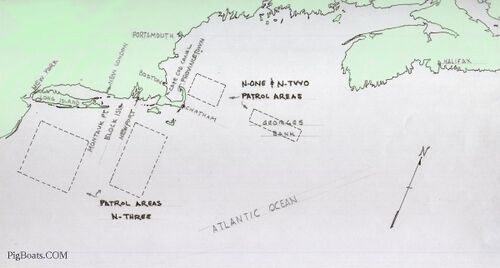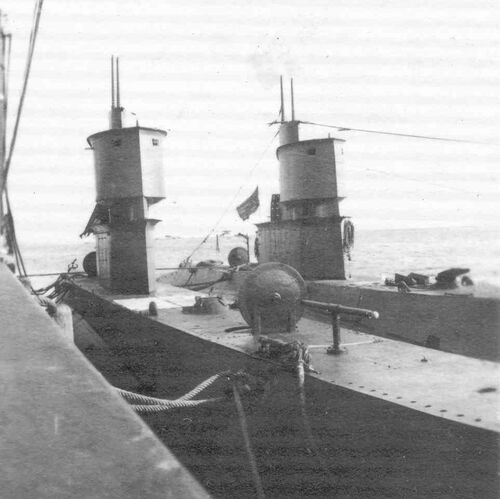General N-class photos

Photo courtesy of NARA Seattle.

N-1, N-2 and N-3 sailing through ice bound waters of Long Island Sound following a track broken for them by the tender USS Savannah (AS-8) as the subs approach the Thames River, Connecticut after sailing from Seattle, Washington. The submarines departed Seattle on November 21, 1917 and arrived at New London on February 7, 1918.
U.S. Navy photo.

From the Dictionary of American Naval Fighting Ships (DANFS) comes the following text: Designed as coast defense submarines, N-l, N-2 and N-3 were fitted out at Puget Sound Navy Yard and then departed November 21, 1917 for San Francisco in company with each other. Reassigned to the East Coast, they departed San Francisco December 13 for Balboa, Canal Zone and thence proceeded via Cristobal, C.Z., Jamaica, Key West, and Norfolk, to New London, Conn., arriving February 7, 1918.
Reporting for duty to Commander, 1st Naval District, the submarines began their first patrols June 23 by hunting for U-boats reported in the vicinity of Cape Cod. After an intensive but fruitless search, N-1 continued her patrol off the New England Coast.
N-2 patrolled off the Georges Bank and the N-3 patrolled along Long Island and associated waters.
For the remainder of the war and until early 1922, N-boats continued operations in the area from New London to Bar Harbor.
The chart seen above was drawn by Bill Lightfoot, author of the book "Beneath the Surface, World War I Submarines Built in Seattle and Vancouver". Reconstructed from the logbooks of the submarines.
Chart created by Bill Lightfoot. His archive is now in the collection of Ric Hedman.

Three Lake-design N-boats are shown here moored to a pier (foreground) at the New York Navy Yard in Brooklyn, shortly after the end of WW I, late 1918. The boats cannot be identified. The fourth boat in the nest is an EB-design O-boat, with at least two more of them moored in a nest in the background under the large hammerhead crane. This was a time of uncertainty within the Navy, as the service adjusted to the new realities of what was falsely believed to be a lasting peace. These N-boats were not well liked by the Navy and would be discarded within a few years. The EB-design O-boats would continue to serve for many more years, even in WW II.
Photo in the private collection of Ric Hedman.

N-1 and N-2 sharing a mooring to a barge off Provincetown, Massachusetts, early 1920's. The open hatch on N-2 leads to the torpedo room, and the T-shaped object on deck is the trainable SC series sonar head.
Photo in the private collection of Ric Hedman.
Page created by:
Ric Hedman & David Johnston
1999 - 2023 - PigBoats.COM©
Mountlake Terrace, WA, Norfolk, VA
webmaster at pigboats dot com
